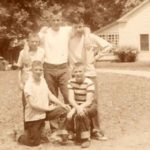Pat O’Dea, “Wisconsin’s Kangaroo,” played at a time when the kicker was considered the most important player on a football team.
O’Dea is thought by many to be the greatest kicker of all time. Pat played for the University of Wisconsin from 1896 to 1899, at a time when the football looked more like a basketball, and the game was played on a 110-yard field.
Scoring was different then. A ball kicked through the goalposts counted five points and a touchdown counted four points. Pat O’Dea holds the record for the longest college punt ever in an 1887 game against Minnesota; 110 yards, the full length of the football field.
O’Dea was six-foot tall and 169 pounds, not big by today’s standards. Being from Australia, he’d learned a running punt and drop-kick style. He attained his power through his forward momentum and a kick in which he left the turf with both feet, his left foot leaving the ground by eight inches and his right foot swung high over his head.
He not only kicked a long punt, but he was also a master of the drop-kick field goal; his longest being sixty-three yards against Northwestern in a raging snowstorm. A round pointed ball creates a truer bounce for a drop kick, but it impedes the flight of a punted ball.
O’Dea was revered by football fans of his time. Wisconsin’s 1900 yearbook posted a tribute to his talents with this poem:
The grandstand is a howling mass,
The lines are crowded thick;
Now center makes a clever pass,
When Pat goes back to kick.
Unerringly the pigskin flies
Above the goal’s cross sticks;
The rooter’s rah-rahs rend the skies
When Pat goes back to kick.
Jim Thorpe has been called the greatest professional kicker of all time, believed to have kicked a 99-yard punt while playing for the Canton Bulldogs, but there’s no record to verify that kick.
Like Jim Thorpe, another Thorpe, my father Harold A. Thorpe, was a fine punter, too. His teammates told me that he punted a hundred yards in a high school game, but I find no record of that either. As a sophomore triple-threat back on a 1929 Stoughton, Wisconsin, undefeated team, he averaged 42 yards a punt. And that was with a plump, basketball-like rounded football.
Wisconsin State Journal’s renowned sport’s columnist, Roundy Coughlin, wrote about him:
“And this Harold Thorpe is a bear. You never saw better high school punting in your life than Thorpe did with a wet, muddy ball with mighty bad field for punting. And he gets them off with speed and (no) unnecessary effort in his work. That is the way Leo Harmon used to kick. He is a sweet passer, and he can run a broken field plenty. There is a football player, this Thorpe. He kicked Stoughton out of danger at least five times with punts that were good enough for Big Ten kickers. . . . He should make one of the greatest backs in this part of the state next year, and how, he is only a sophomore.”
After high school, Dad was offered a tryout by the Green Bay Packers, but punting specialists didn’t exist in the 1930s, so he’d have to make the Packer team as a full-time player. At the time, Packer players’ salaries were dependent on community fund drives, and being at the beginning of the Great Depression, funds were limited and uncertain.
Their best players received around $100 to $200 a year. Their coach and manager, Curly Lambeau, was thought to be cheap, and he wasn’t much liked by some of his players. Hall of Fame player Cal Hubbard was said to have proclaimed, “They won’t be able to find six men to bury the ….”
Although the Packers began in 1919 by employing local high school players, by the 1930s, Lambeau recruited from colleges and other pro teams throughout the nation. So employing or retaining a high school player had become rare.
Dad decided to continue his football at Ripon College, where he received full financial support, although that was probably not listed on their books.
He was class president at Ripon his freshman year but was almost killed in a car accident before that year ended—the end of a promising football career.









